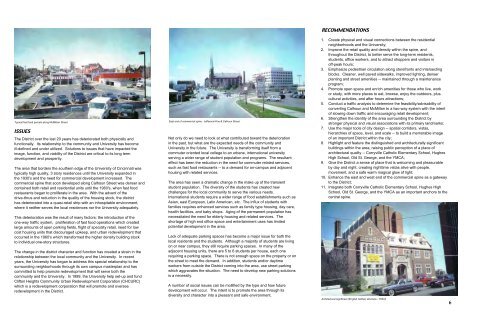CLIFTON HEIGHTS / UC JOINT URBAN RENEWAL PLAN
Clifton Heights / UC Joint Urban Renewal Plan - University of ...
Clifton Heights / UC Joint Urban Renewal Plan - University of ...
- No tags were found...
Create successful ePaper yourself
Turn your PDF publications into a flip-book with our unique Google optimized e-Paper software.
Typical fast-food parcels along McMillian StreetISSUESThe District over the last 20 years has deteriorated both physically andfunctionally. Its relationship to the community and University has becomeill-defined and under utilized. Solutions to issues that have impacted theimage, function, and viability of the District are critical to its long termdevelopment and prosperity.The area that borders the southern edge of the University of Cincinnati wastypically high quality, 3 story residences until the University expanded inthe 1930's and the need for commercial development increased. Thecommercial spine that soon developed along Calhoun Street was denser andcontained both retail and residential units until the 1960's, when fast foodrestaurants began to proliferate in the area. With the advent of thedrive-thrus and reduction in the quality of the housing stock, the districthas deteriorated into a quasi-retail strip with an inhospitable environment,where it neither serves the local residences nor the University adequately.This deterioration was the result of many factors: the introduction of theone-way traffic system, proliferation of fast food operations which createdlarge amounts of open parking fields, flight of specialty retail, need for lowcost housing units that discouraged upkeep, and urban redevelopment thatoccurred in the 1960's which transformed the higher density building stockto individual one-story structures.The change in the district character and function has created a strain in therelationship between the local community and the University. In recentyears, the University has began to address this special relationship to thesurrounding neighborhoods through its own campus masterplan and hascommitted to help promote redevelopment that will serve both thecommunity and the University. In 1999, the University help set-up and fundClifton Heights Community Urban Redevelopment Corporation (CHCURC)which is a redevelopment corporation that will promote and overseeredevelopment in the District.East end of commercial spine - Jefferson/Vine & Calhoun StreetNot only do we need to look at what contributed toward the deteriorationin the past, but what are the expected needs of the community andUniversity in the future. The University is transforming itself from acommuter oriented local college to an urbane, international universityserving a wider range of student population and programs. The resultanteffect has been the reduction in the need for commuter related services,such as fast food restaurants -- to a demand for on-campus and adjacenthousing with related services.The area has seen a dramatic change in the make up of the transientstudent population. The diversity of the students has created newchallenges for the local community to serve the various needs.International students require a wider range of food establishments such asAsian, east European, Latin American, etc. The influx of students withfamilies requires enhanced services such as family type housing, day care,health facilities, and baby shops. Aging of the permanent population hasnecessitated the need for elderly housing and related services. Theshortage of high end office space and entertainment uses has limitedpotential development in the area.Lack of adequate parking spaces has become a major issue for both thelocal residents and the students. Although a majority of students are livingon or near campus, they still require parking spaces. In many of theadjacent housing units, there are 5 to 6 students per house, each onerequiring a parking space. There is not enough space on the property or onthe street to meet the demand. In addition, students and/or daytimeworkers from outside the District coming into the area, use street parkingwhich aggravates the situation. The need to develop new parking solutionsis a necessity.A number of social issues can be mollified by the type and how futuredevelopment will occur. The intent is to promote the area through itsdiversity and character into a pleasant and safe environment.RECOMMENDATIONS1. Create physical and visual connections between the residentialneighborhoods and the University;2. Improve the retail quality and density within the spine, andthroughout the District, to better serve the long-term residents,students, office workers, and to attract shoppers and visitors inoff-peak hours;3. Emphasize pedestrian circulation along storefronts and intersectingblocks. Cleaner, well paved sidewalks, improved lighting, denserplanting and street amenities -- maintained through a maintenanceprogram;4. Promote open space and enrich amenities for those who live, workor study, with more places to eat, browse, enjoy the outdoors, pluscultural activities, and after hours attractions;5. Conduct a traffic analysis to determine the feasibility/advisability ofconverting Calhoun and McMillan to a two-way system with the intentof slowing down traffic and encouraging retail development;6. Strengthen the identity of the area surrounding the District bystronger physical and visual associations with its primary landmarks;7. Use the major tools of city design -- spatial corridors, vistas,hierarchies of space, level, and scale -- to build a memorable imageof an important District within the city;8. Highlight and feature the distinguished and architecturally significantbuildings within the area, raising public perception of a place ofarchitectural quality -- Corryville Catholic Elementary School, HughesHigh School, Old St. George, and the YMCA;9. Give the District a sense of place that is welcoming and pleasurableby day and night, creating nighttime vistas alive with people,movement, and a safe warm magical glow of light;10. Enhance the east and west end of the commercial spine as a gatewayto the District;11. Integrate both Corryville Catholic Elementary School, Hughes HighSchool, Old St. George, and the YMCA as an important anchors to thecentral spine.Architectural significant (English Gothic) structure - YMCA6



